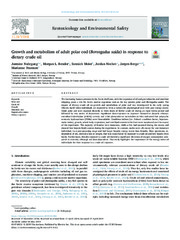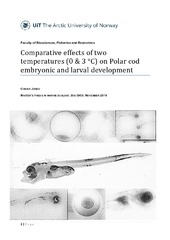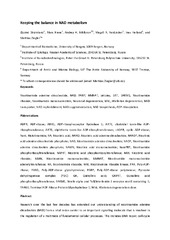Institutt for arktisk og marin biologi: Nye registreringer
Viser treff 1181-1200 av 2084
-
Growth and metabolism of adult polar cod (Boreogadus saida) in response to dietary crude oil
(Journal article; Tidsskriftartikkel; Peer reviewed, 2019-05-06)The increasing human presence in the Arctic shelf seas, with the expansion of oil and gas industries and maritime shipping, poses a risk for Arctic marine organisms such as the key species polar cod (<i>Boreogadus saida</i>). The impact of dietary crude oil on growth and metabolism of polar cod was investigated in the early spring (March–April) when individuals are expected to be in a vulnerable ... -
Comparative effects of two temperatures (0 & 3 °C) on Polar cod embryonic and larval development
(Master thesis; Mastergradsoppgave, 2019-11-14)Polar cod (Boreogadus saida) are particularly vulnerable to climate change. Increasing our knowledge of polar cod development will help improve our understanding of the impact of climate change and the impacts this might have on the population. This study aimed at characterizing the development of Polar cod from fertilisation to 86 days post fertilisation (dpf) at two temperatures within their ... -
Recreational fisheries target declining populations of brown trout (Salmo trutta L.) in Northern Norway as revealed by a genome wide array of SNP markers
(Master thesis; Mastergradsoppgave, 2019-11-15)Marine recreational and commercial exploitation of salmonids often target a mixed stock consisting of genetically distinct and independent populations with varying abundances, life histories, standing genetic variation, and conservation status. In this study we use SNP markers to investigate the genetic population structure of juvenile brown trout (Salmo trutta L.) from five distinct watercourses ... -
Keeping the balance in NAD metabolism
(Journal article; Tidsskriftartikkel; Peer reviewed, 2019-01-09)Research over the last few decades has extended our understanding of nicotinamide adenine dinucleotide (NAD) from a vital redox carrier to an important signalling molecule that is involved in the regulation of a multitude of fundamental cellular processes. This includes DNA repair, cell cycle regulation, gene expression and calcium signalling, in which NAD is a substrate for several families of ... -
Effect of incubation temperature on eggs and larvae of lumpfish (Cyclopterus lumpus)
(Journal article; Tidsskriftartikkel; Peer reviewed, 2018-08-24)Two batches of lumpfish eggs were incubated at three temperature regimes; 1-Ambient seawater 4–6 °C (cold), 2-Ambient seawater for 10 days followed by a gradual increase to 10 °C (gradient), 3-Constant 10 °C seawater (warm). The eggs incubated in cold water had the highest egg mortality (38.5% ± 15.7) and lowest hatching success (46.1% ± 7.2), while the gradient group regime showed highest hatching ... -
Mesopelagic sound scattering layers of the high Arctic: Seasonal variations in biomass, species assemblage, and trophic relationships
(Journal article; Tidsskriftartikkel; Peer reviewed, 2019-07-12)Mesopelagic sound scattering layers (SSL) are ubiquitous in all oceans. Pelagic organisms within the SSL play important roles as prey for higher trophic levels and in climate regulation through the biological carbon pump. Yet, the biomass and species composition of SSL in the Arctic Ocean remain poorly documented, particularly in winter. A multifrequency echosounder detected a SSL north of Svalbard, ... -
Ambient temperature effects on stress-induced hyperthermia in Svalbard ptarmigan
(Journal article; Tidsskriftartikkel; Peer reviewed, 2019-06-20)Stress-induced hyperthermia (SIH) is commonly observed during handling in homeotherms. However, in birds, handling in cold environments typically elicits hypothermia. It is unclear whether this indicates that SIH is differently regulated in this taxon or if it is due to size, because body temperature changes during handling in low temperatures have only been measured in small birds <0.03 kg (that ... -
Terrestrial locomotion of the Svalbard rock ptarmigan: comparing field and laboratory treadmill studies
(Journal article; Tidsskriftartikkel; Peer reviewed, 2019-08-07)Research into the terrestrial locomotion of birds is often based upon laboratory treadmill experiments. However, it is unclear how transposable these results are for birds moving in the wild. Here, using video recordings, we compared the kinematics of locomotion (stride frequency, stride length, stance phase, swing phase, duty factor) and speed range of Svalbard rock ptarmigan (<i>Lagopus muta ... -
The epidemiology of zoonotic brucellosis in Bahr el Ghazal region of South Sudan
(Journal article; Tidsskriftartikkel; Peer reviewed, 2019-06-26)<p><i>Background - </i>In this study, we focused on three zoonotic brucellosis risk groups; abattoir workers, febrile cases at Wau hospital and cattle herders, in Bahr el Ghazal region, South Sudan. Competitive c-ELISA was used to detect anti-<i>Brucella</i> antibodies in 725 individuals between December 2015 and May 2016. In addition, questionnaire metadata, focus group discussions and key informant ... -
Phylogenetic Reclassification of Vertebrate Melatonin Receptors To Include Mel1d
(Journal article; Tidsskriftartikkel; Peer reviewed, 2019-10-01)The circadian and seasonal actions of melatonin are mediated by high affinity G-protein coupled receptors (melatonin receptors, MTRs), classified into phylogenetically distinct subtypes based on sequence divergence and pharmacological characteristics. Three vertebrate MTR subtypes are currently described: MT1 (MTNR1A), MT2 (MTNR1B), and Mel1c (MTNR1C / GPR50), which exhibit distinct affinities, ... -
Seasonal shifts in feeding patterns: Individual and population realized specialization in a high Arctic fish
(Journal article; Tidsskriftartikkel; Peer reviewed, 2019-09-21)Species with a broad and flexible diet may be at an advantage in a rapidly changing environment such as in today's Arctic ecosystems. Polar cod (<i>Boreogadus saida</i>), an abundant and ecologically important circumpolar Arctic fish, is often described as a zooplankton generalist feeder, which suggests that it may cope successfully with changes in prey composition. This description is justified ... -
The PI3K and MAPK/p38 pathways control stress granule assembly in a hierarchical manner
(Journal article; Tidsskriftartikkel; Peer reviewed, 2019-03-28)All cells and organisms exhibit stress-coping mechanisms to ensure survival. Cytoplasmic protein-RNA assemblies termed stress granules are increasingly recognized to promote cellular survival under stress. Thus, they might represent tumor vulnerabilities that are currently poorly explored. The translation-inhibitory eIF2α kinases are established as main drivers of stress granule assembly. Using a ... -
Multi-pathogen serological survey of migratory caribou herds: A snapshot in time
(Journal article; Tidsskriftartikkel; Peer reviewed, 2019-07-31)Pathogens can impact host survival, fecundity, and population dynamics even when no obvious disease is observed. Few baseline data on pathogen prevalence and diversity of caribou are available, which hampers our ability to track changes over time and evaluate impacts on caribou health. Archived blood samples collected from ten migratory caribou herds in Canada and two in Greenland were used to test ... -
The association between parasite infection and growth rates in Arctic charr: do fast growing fish have more parasites?
(Journal article; Tidsskriftartikkel; Peer reviewed, 2019-01-01)Trophically transmitted parasites are known to impair fish growth in experimental studies, but this is not well documented in natural populations. For Arctic charr [<i>Salvelinus alpinus</i> (L.)], individual growth is positively correlated with food consumption. However, increased food consumption will increase the exposure to trophically transmitted parasites. Using a correlative approach, we ... -
Fish culling reduces tapeworm burden in Arctic charr by increasing parasite mortality rather than by reducing density-dependent transmission
(Journal article; Tidsskriftartikkel; Peer reviewed, 2019-02-25)<ol> <li>Two common <i>Dibothriocephalus</i> (formerly <i>Diphyllobothrium</i>) tapeworm species were significantly reduced by experimental culling of their fish host Arctic charr (<i>Salvelinus alpinus</i>) in a subarctic lake.</li><p> <p><li>Between 1984 and 1991, funnel traps were used to cull ~35 metric tons of Arctic charr, reducing charr density by ~80%. As charr densities decreased, ... -
Influence of Phytoplankton Advection on the Productivity Along the Atlantic Water Inflow to the Arctic Ocean
(Journal article; Tidsskriftartikkel; Peer reviewed, 2019-09-27)Northwards flowing Atlantic waters transport heat, nutrients, and organic carbon in the form of zooplankton into the eastern Greenland Sea and Fram Strait. Less is known of the contribution of phytoplankton advection in this current, the Atlantic Water Inflow (AWI) spanning from the North Atlantic to the Arctic Ocean. The <i>in situ</i> and advected primary production was estimated using the ... -
Some observations of Cancer pagurus Linnaeus, 1758 (Decapoda, Brachyura) in deep water
(Journal article; Tidsskriftartikkel; Peer reviewed, 2019-01-01)Available species information pages and fact sheets define 100 to 200 m as the maximum depth of occurrence for <i>Cancer pagurus</i>. We here present some observations from video transects conducted in Sognesjøen, Norway, where numerous individuals of adult <i>C. pagurus</i> were observed at more than 400 m depth. Within the area investigated, 81 live crabs, 3 dead crabs/exuviae, and 32 areas with ... -
Epifaunal communities across marine landscapes of the deep Chukchi Borderland (Pacific Arctic)
(Journal article; Tidsskriftartikkel; Peer reviewed, 2019-06-27)Epifaunal communities from the poorly studied Arctic deep sea of the Chukchi Borderland region were investigated to: (1) determine differences in community structure among ridges, plateau with pockmarks, and much deeper basins as three main habitat types, (2) analyse the environmental factors that might shape these communities, and (3) investigate biogeographic affinities dominating the epifaunal ... -
Identification of evolutionary and kinetic drivers of NAD-dependent signaling
(Journal article; Tidsskriftartikkel; Peer reviewed, 2019-07-24)Nicotinamide adenine dinucleotide (NAD) is best known as an essential cofactor of biochemical reactions. In addition, it is involved in the regulation of virtually all major cellular events. These NAD-dependent regulatory functions are mediated by enzymes (e.g., sirtuins, poly–adenosine -diphosphate [ADP] ribose polymerases, ADP-ribosyl cyclases) that cleave the molecule to liberate nicotinamide ... -
Life cycle assessment of recirculating aquaculture systems: A case of Atlantic salmon farming in China
(Journal article; Tidsskriftartikkel; Peer reviewed, 2019-04-01)Recirculating aquaculture systems (RAS) are an alternative technology to tackle the major environmental challenges associated with conventional cage culture systems. In order to systematically assess the environmental performance of RAS farming, it is important to take the whole life cycle into account so as to avoid ad hoc and suboptimal environmental measures. So far, the application of life cycle ...


 English
English norsk
norsk


















